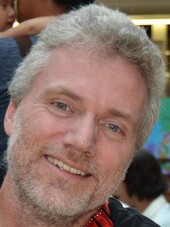Kai Uwe Martens
|
 |
"Physics or philosophy?" was the question that got answered when in 1994 I received my Ph.D. from Heidelberg University in Germany. It was earned during five exciting years on a hyperon beam experiment at CERN.
In 1995 I came to the University of Tokyo and Kamioka, where we built the Super-Kamiokande (SK) detector. Later I also helped build detectors for the K2K experiment at KEK in Tsukuba. Upon my return in 2008 to Kamioka I re-joined SK to continue working on solar neutrinos and to patiently wait for the neutrinos to arrive from a galactic Supernova. Our collaboration's work on SK was awarded the Asahi Prize in 1998 and, including our work on K2K, the Breakthrough Prize in 2015. And of course there is the Nobel Prize that Takaaki Kajita and Art McDonald won "for the discovery of neutrino oscillations, which shows that neutrinos have mass".
In 2000 I became faculty at the University of Utah. Results from our HiRes experiment in Utah changed the paradigm in cosmic ray physics: The CZK-cutoff exists! The Telescope Array experiment continues taking data near Delta, Utah, to this day, and I had a major role in bringing that about.
Arguably the biggest problem in contemporary experimental physics is the nature of dark matter. Upon returning to Kamioka in 2008 I joined XMASS, which had a great run with many interesting results. My group is investigating Machine Learning to see if we can still learn new things from the existing five full years of XMASS data.
Japan has joined the second generation (G2) dark matter experiment XENONnT to hopefully discover weakly interacting massive particles - still a leading candidate for understanding what dark matter is composed of. Together with my co-PI at Kavli IPMU and colleague from ICRR at the University of Tokyo Shigetaka Moriyama I spearheaded this effort. It is through our effort that Japan is bringing the water Cherenkov technology developed by Kavli IPMU PI Mark Vagins and his colleagues to detect neutrons by dissolving a gadolinium salt in Super-Kamiokande to XENONnT for its neutron veto - the first time this new technology will be applied outside of the neutrino sector. We are also integrating our XMASS knowledge of liquid xenon purification with that of the XENON collaboration.
Experimental data are the foundation of knowledge, and knowledge is what we seek at Kavli IPMU. Here we integrate the insights data provides with the structures mathematics provides by the collective effort and skill of theorists, experimentalists, mathematicians, and philosophers - a great place to be, a great place to keep learning.
Back to Member List.






